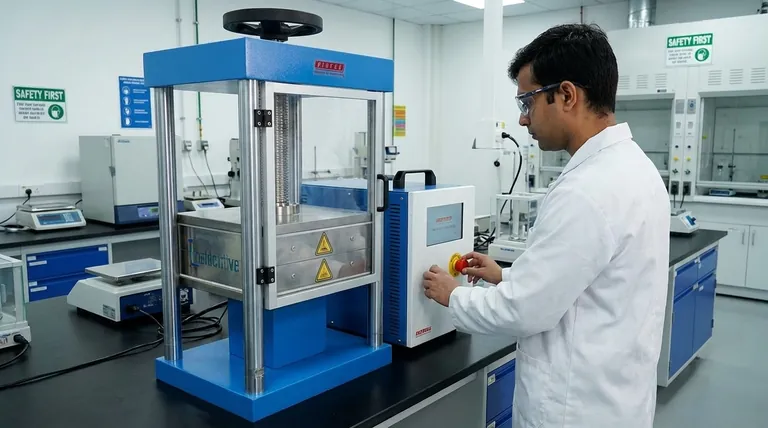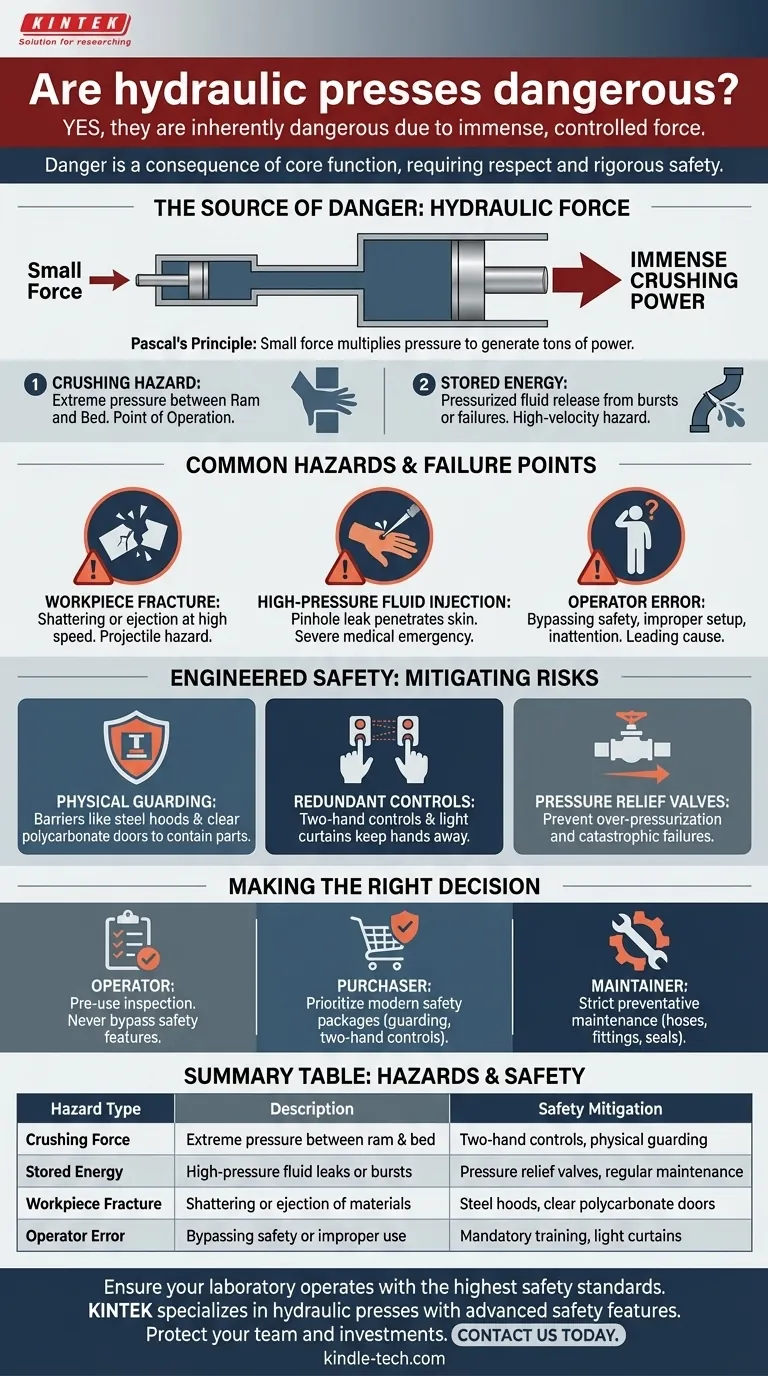Yes, hydraulic presses are inherently dangerous. They are designed to generate immense, controlled force, and it is this power that makes them both incredibly useful and potentially hazardous. The danger does not stem from a flaw in their design but is a direct consequence of their core function. Understanding and respecting this power is the key to safe operation.
The immense force that makes a hydraulic press a powerful tool is also the primary source of its danger. Consequently, safety is not an afterthought but a fundamental requirement managed through engineered guards, redundant controls, and rigorous operational procedures.
The Source of the Danger: Understanding Hydraulic Force
A hydraulic press operates on a simple principle that allows it to multiply force to extreme levels. This amplification of force is the root of the primary hazard.
Pascal's Principle in Action
A hydraulic system uses an incompressible fluid (typically oil) to transmit force. A small amount of force applied to a small piston generates immense pressure in the fluid. This pressure then acts on a much larger piston, multiplying the initial force significantly. This is how a simple hand pump can generate tons of crushing power.
The Primary Crushing Hazard
The most obvious and severe risk is the crushing force exerted between the press's ram (the moving part) and the bed (the stationary part). Anything caught in this "point of operation"—a hand, a tool, or the workpiece itself—will be subjected to forces capable of causing catastrophic injury or equipment damage.
Stored Energy Risks
The pressurized hydraulic fluid is a form of stored energy. If a hydraulic line were to burst or a fitting were to fail, this energy could be released suddenly and violently. This can result in high-velocity fluid injection injuries or the whipping of failed hoses.
Common Hazards and Failure Points
While modern presses are built with safety in mind, accidents typically occur due to one of three factors: mechanical failure, hydraulic failure, or operator error.
Workpiece Fracture
When a workpiece is placed under extreme pressure, it can fracture, shatter, or be ejected from the press at high speed. This creates a projectile hazard for anyone in the vicinity.
High-Pressure Fluid Injection
A pinhole leak in a hydraulic hose can release a nearly invisible stream of fluid at a pressure high enough to penetrate human skin. This is a severe medical emergency that can lead to tissue death, amputation, or fatal complications if not treated immediately by a specialist.
Operator Error
The most common cause of accidents is human error. This includes bypassing safety features, improper setup of the workpiece, wearing loose clothing or jewelry, or simple inattention. Lack of proper training is a major contributor to these errors.
Engineered Safety: How the Dangers Are Mitigated
Manufacturers are acutely aware of these risks and incorporate multiple layers of safety features into modern hydraulic press designs.
Physical Guarding
As noted in laboratory press designs, presses are often equipped with physical barriers. These can include a heavy-gauge steel hood to contain parts in case of a workpiece failure and a clear polycarbonate door that prevents access to the danger zone while allowing the operator to monitor the process.
Redundant Control Systems
Many presses require two-hand controls, forcing the operator to use both hands to activate the press ram. This ensures their hands are safely away from the point of operation. Light curtains, which use infrared beams to detect an object, can also automatically stop the press if a hand or arm enters the danger zone.
Pressure Relief Valves
Every hydraulic system is equipped with pressure relief valves. These are critical safety devices that prevent the system from becoming over-pressurized. If the pressure exceeds a set limit, the valve opens to bleed off the excess, preventing a catastrophic failure of hoses or cylinders.
Making the Right Decision for Your Operation
Understanding the risks is the first step toward safe and effective use. Your approach should be dictated by your specific role.
- If your primary focus is operating a press safely: Always perform a pre-use inspection, confirm all guards are in place and functional, and never, under any circumstances, bypass a safety feature.
- If your primary focus is purchasing a new press: Prioritize models with comprehensive, modern safety packages, including full physical guarding, certified two-hand controls or light curtains, and clear documentation.
- If your primary focus is maintaining an existing press: Implement and follow a strict preventative maintenance schedule, paying special attention to the condition of hydraulic hoses, fittings, seals, and fluid levels.
With proper respect for its power and adherence to safety protocols, a hydraulic press is an indispensable and controllable industrial tool.

Summary Table:
| Hazard Type | Description | Safety Mitigation |
|---|---|---|
| Crushing Force | Extreme pressure between ram and bed | Two-hand controls, physical guarding |
| Stored Energy | High-pressure fluid leaks or bursts | Pressure relief valves, regular maintenance |
| Workpiece Fracture | Shattering or ejection of materials | Steel hoods, clear polycarbonate doors |
| Operator Error | Bypassing safety or improper use | Mandatory training, light curtains |
Ensure your laboratory operates with the highest safety standards. KINTEK specializes in lab equipment and consumables, offering hydraulic presses with advanced safety features like redundant controls and full guarding. Protect your team and your investments—contact us today to find the right press for your needs!
Visual Guide

Related Products
- Laboratory Hydraulic Press Split Electric Lab Pellet Press
- Laboratory Hydraulic Press Lab Pellet Press Machine for Glove Box
- Automatic Laboratory Hydraulic Press for XRF & KBR Pellet Press
- Automatic High Temperature Heated Hydraulic Press Machine with Heated Plates for Lab
- 24T 30T 60T Heated Hydraulic Press Machine with Heated Plates for Laboratory Hot Press
People Also Ask
- Why do we use KBr in FTIR? The Key to Clear, Accurate Solid Sample Analysis
- What is a hydraulic press for sample preparation? Create Consistent Pellets for Reliable Analysis
- What is an example of a hydraulic press? Discover the Power of Laboratory Sample Preparation
- How much force can a hydraulic press exert? Understanding its immense power and design limits.
- What is the purpose of KBr pellets? Unlock Clear FTIR Analysis of Solid Samples



















